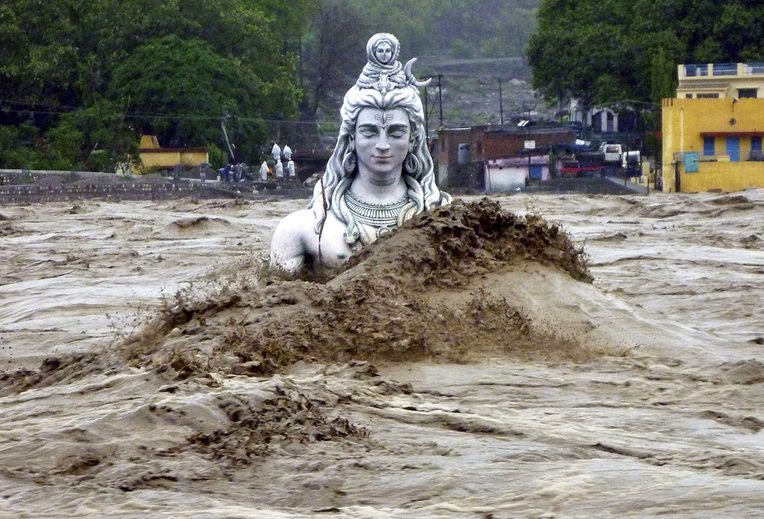Predation
From the Series: Lexicon for an Anthropocene Yet Unseen
From the Series: Lexicon for an Anthropocene Yet Unseen

The Anthropocene initiates new discussions not just about the agency of anthropos, but also about how we are to understand agentive action and planetary impact beyond the human (Latour 2014). I propose predation as a means whereby we can expand our vocabulary and imagination of what life in the Anthropocene is or might come to be. Predation operates here in its dual sense: the preying of a living being upon another, as well as the act of looting.
In the Indian Himalaya, in a small state called Uttarakhand, big cats are increasingly preying upon humans. The marked exacerbation in human-cat conflict is, according to many, a direct outcome of climate change (see Mathur 2015). Man-eaters, or cats that eat humans, have a long and intriguing history in India (Pandian 2001). How, then, has this newfound link between climate change and the most literal sense of predation come to be?
Official statistics in Uttarakhand corroborate the general consensus that man-eaters are most active in the winter season. According to one popular state narrative, winter snowfall pushes leopards from the higher reaches of the Himalayas to spaces inhabited by humans. Previously, there was abundant nonhuman prey available for them. However, due to resource degradation, biodiversity depletion, and species extinction—all exacerbated by climate change in the Himalaya—the big cats face sparser hunting options. Deprived of their regular prey, they turn on humans.
Similar to the increase in man-eaters, there has been a steady increase in human-bear conflict in the same region of the Himalaya. Once again, officials have explained this upswing in attacks on humans by wild bears as a consequence of climate change. The rationale goes that due to global warming, it has become so hot even in the Upper Himalaya that the bears have been “driven mad” (pagal ho gaye hai) by the heat. These heat-crazened bears go on to indulge in random and inexplicable acts of violence, such as the mauling of humans and destruction of their property.
Nonhuman animals attacking, mauling, and eating humans in ever-rising numbers is, if we are to believe these state accounts, but one manifestation of life in the Anthropocene. But what of anthropos itself as a predator?
There is an emergent consensus that climate change is a result of the (de)predations of capitalism (Klein 2014). Distinct from the universalism of capitalism versus climate that appears in the title of Naomi Klein’s manifesto, localized and historicized accounts of colonial, postcolonial, and corporate plunder of the Himalaya proliferate in Uttarakhand. Here, certain specified and frequently named human constituencies—those hailing from the distant plains of India (maidani), the agents of the state, and corporations—are considered to be preying upon the rich resources of the upper Himalaya. According to these accounts, it is the longstanding practices of animal poaching and trafficking, deforestation, resource extraction, mining, damming of rivers, incessant construction, and the commercialization of all domains of life that have depleted the Himalaya.
Is it not, then, darkly apposite that the predator—human beings—is to be predated upon by nonhuman animals—big cats and bears—in this age of the Anthropocene in the Himalaya?
Mutual predation is not, however, restricted to animals and humans in this epoch. Rivers, mountains, soil, and even the gods are furious at humans for their wanton destruction of the Himalaya. This fury is expressed in diverse ways, with a prominent mode being recurrent disasters (apada) such as floods, famines, avalanches, forest fires, and earthquakes. In Uttarakhand, there was one apada that occurred in June 2013 that was especially devastating, with 5,500 people oficially declared dead (although unofficial accounts put the toll at closer to 10,000). Following several days of unremitting monsoon rain and—it is speculated—cloud bursts, flash floods inundated several regions of Uttarakhand. In addition to the uncharacteristically fierce monsoon conditions, a contributing factor to the floods was the moraine left behind by the retreating Chorabari glacier. The monsoon rain filled the rock debris reservoir of the moraine and soon overflowed to join the flooding river. It was the combined force of the two that led to the raging floodwaters.
In a region where one apada or another is now expected on a seasonal, if not daily, basis, the floods of 2013 are marked as exceptional. Even in the otherwise prosaic and self-consciously secularizing bureaucratic language of the Indian state, they were termed a daiviya apada or divine disaster. The disaster was considered divine, in part, because the scale of destruction could only ever be wreaked by gods and demons. As eyewitnesses, victims, and residents of Uttarakhand describe and remember it, the floods and rains felt like the furious tandava dance of the Hindu god Shiva and must certainly have been prakriti ka prakop (retribution by Nature).
The greatest number of casualties and the most damage took place in the holy town of Kedarnath, which is centered around an ancient Shiva temple from the eighth century. As Shiva danced his dance of death and destruction, he made sure to protect his own temple. Witnesses describe hearing a huge snapping noise, followed by a gigantic wall of water descending on the Kedarnath temple and its surroundings. Miraculously, a huge boulder got lodged behind the temple, protecting it from any major damages. The location of the temple, as well as its strong construction, protected it. Such protection was not at hand for the surrounding buildings, which were swept away in the flood. Thousands of humans, largely pilgrims, were met with the same fate, even as others got buried alive under landslides.

The image that has become iconic of the divine disaster, however, is one taken much further downstream from Kedarnath in the town of Rishikesh. In it, we see the flooding Ganges river partially submerging a popular Shiva idol. With his closed eyes and beatific smile, it is as if Shiva the Destroyer was resting at the end of his dance of rage. The divine disaster is discussed as a chilling foreshadowing of the Anthropocene yet unseen: an age in which prey will become indistinguishable from predator. This is a world in which big cats, bears, rivers, glaciers, mountains, clouds, humans, and gods will all act with a hitherto unknown extremity, ferocity, and unpredictability.
Klein, Naomi. 2014. This Changes Everything: Capitalism versus the Climate. New York: Simon and Schuster.
Latour, Bruno. 2014. “Agency at the Time of the Anthropocene.” New Literary History 45, no. 1: 1–18.
Mathur, Nayanika. 2015. “‘It’s a Conspiracy Theory and Climate Change’: Of Beastly Encounters and Cervine Disappearances in Himalayan India.” HAU: Journal of Ethnographic Theory 5, no. 1: 87–111.
Pandian, Anand S. 2001. “Predatory Care: The Imperial Hunt in British and Mughal India.” Journal of Historical Sociology 14, no. 1: 79–107.